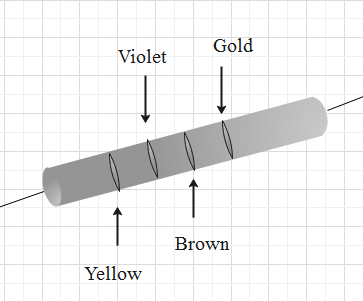
The figure shows a colour-coded resistor the resistance of this resistor is:

(A) $ \left( {52 \times {{10}^3} \pm 20\% } \right)\Omega $
(B) $ \left( {47 \times {{10}^1} \pm 5\% } \right)\Omega $
(C) $ \left( {53 \times {{10}^6} \pm 5\% } \right)\Omega $
(D) $ \left( {42 \pm 20\% } \right)\Omega $

Answer
568.2k+ views
Hint
In this given problem, as the resistor has 4 bands, the third digit is a multiplier, its value (the digit) should be the power of 10. Similarly, the fourth digit is a tolerance, its value (the digit) should be written as a percentage with +/- sign.
$ \left[ {10 \times \left( {{\text{digit 1}}} \right) + 1 \times \left( {{\text{digit 2}}} \right)} \right]{\text{Multiplier}} \pm {\text{Error}} $ .
Complete step by step solution
From the given figure, we have the data,
The resistor code for the colour yellow is 4.
The resistor code for the colour violet is 7.
The resistor code for the colour brown is 1.
The error that is tolerance due to the gold is $ \pm 5\% $ .
Therefore, as per the diagram, the yellow band is the first band. So, the first digit will be 4.
Similarly, as per the diagram, the violet band is the second band. So, the second digit will be 7.
Similarly, as per the diagram, the brown band is the third band. So, the multiplier will be $ {10^1} $ .
Finally, we have, the gold band, also called the tolerance band. So, the error will be $ \pm 5\% $ .
The formula for calculating the resistance of the resistor using the colour code of the resistor is given as follows.
$ \left[ {10 \times \left( {{\text{digit 1}}} \right) + 1 \times \left( {{\text{digit 2}}} \right)} \right]{\text{Multiplier}} \pm {\text{Error}} $
Substitute the obtained values in the formula for calculating resistance to carry out the further calculation.
So, we get,
$ \left[ {10 \times \left( {\text{4}} \right) + 1 \times \left( {\text{7}} \right)} \right]{\text{1}}{{\text{0}}^1} \pm 5\% $
Upon further simplification, we get,
$ \left[ {40 + 7} \right]{\text{1}}{{\text{0}}^1} \pm 5\%
\Rightarrow \left[ {47 \times {{10}^1} \pm 5} \right]\% \Omega $
$ \therefore $ The resistance of the given colour-coded resistor is $ \left( {47 \times {{10}^1} \pm 5\% } \right)\Omega $ .
Thus, the option (B) is correct.
Note
Whatever may be the number of bands on the resistor, the last 2 bands are fixed, one for multiplier (the digit raised to the power of 10) and the other one for tolerance (the digit is written as a percentage with +/- sign).
In this given problem, as the resistor has 4 bands, the third digit is a multiplier, its value (the digit) should be the power of 10. Similarly, the fourth digit is a tolerance, its value (the digit) should be written as a percentage with +/- sign.
$ \left[ {10 \times \left( {{\text{digit 1}}} \right) + 1 \times \left( {{\text{digit 2}}} \right)} \right]{\text{Multiplier}} \pm {\text{Error}} $ .
Complete step by step solution
From the given figure, we have the data,
The resistor code for the colour yellow is 4.
The resistor code for the colour violet is 7.
The resistor code for the colour brown is 1.
The error that is tolerance due to the gold is $ \pm 5\% $ .
Therefore, as per the diagram, the yellow band is the first band. So, the first digit will be 4.
Similarly, as per the diagram, the violet band is the second band. So, the second digit will be 7.
Similarly, as per the diagram, the brown band is the third band. So, the multiplier will be $ {10^1} $ .
Finally, we have, the gold band, also called the tolerance band. So, the error will be $ \pm 5\% $ .
The formula for calculating the resistance of the resistor using the colour code of the resistor is given as follows.
$ \left[ {10 \times \left( {{\text{digit 1}}} \right) + 1 \times \left( {{\text{digit 2}}} \right)} \right]{\text{Multiplier}} \pm {\text{Error}} $
Substitute the obtained values in the formula for calculating resistance to carry out the further calculation.
So, we get,
$ \left[ {10 \times \left( {\text{4}} \right) + 1 \times \left( {\text{7}} \right)} \right]{\text{1}}{{\text{0}}^1} \pm 5\% $
Upon further simplification, we get,
$ \left[ {40 + 7} \right]{\text{1}}{{\text{0}}^1} \pm 5\%
\Rightarrow \left[ {47 \times {{10}^1} \pm 5} \right]\% \Omega $
$ \therefore $ The resistance of the given colour-coded resistor is $ \left( {47 \times {{10}^1} \pm 5\% } \right)\Omega $ .
Thus, the option (B) is correct.
Note
Whatever may be the number of bands on the resistor, the last 2 bands are fixed, one for multiplier (the digit raised to the power of 10) and the other one for tolerance (the digit is written as a percentage with +/- sign).
Recently Updated Pages
A man running at a speed 5 ms is viewed in the side class 12 physics CBSE

The number of solutions in x in 02pi for which sqrt class 12 maths CBSE

State and explain Hardy Weinbergs Principle class 12 biology CBSE

Write any two methods of preparation of phenol Give class 12 chemistry CBSE

Which of the following statements is wrong a Amnion class 12 biology CBSE

Differentiate between action potential and resting class 12 biology CBSE

Trending doubts
What are the major means of transport Explain each class 12 social science CBSE

Which are the Top 10 Largest Countries of the World?

Draw a labelled sketch of the human eye class 12 physics CBSE

Explain sex determination in humans with line diag class 12 biology CBSE

Explain sex determination in humans with the help of class 12 biology CBSE

Differentiate between homogeneous and heterogeneous class 12 chemistry CBSE




